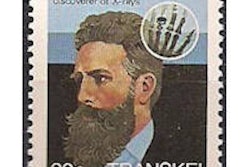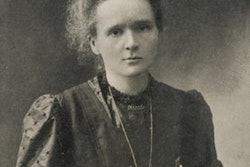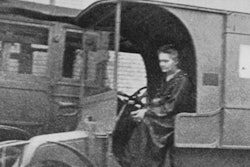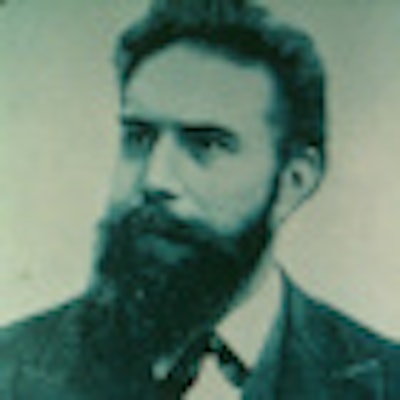
In the second half of the 19th century, academic physicists in Europe and a few in North America spent much of their efforts developing the use of electricity. Many of the same ones were interested in experimenting with the creation of vacuums in sealed glass tubes. Some of them worked in buildings where electric currents had been installed by means of steam generators. Others in their laboratories used static machines where electric currents were created by someone cranking a manual generator.
The U.S. inventor Thomas Edison had worked with electricity and was the developer of light bulbs -- vacuum-sealed small glass bulbs with metal connections and prongs -- which allowed an electric glow to light up rooms, buildings, and streets. Dozens of scientists soon began experimenting with injecting electric current into vacuum tubes. Their ranks included the Serbian inventor Nikola Tesla, who had emigrated to the U.S.; the British physicists William Crookes and Ernest Rutherford; and the German physicists Philipp Lenard and Heinrich Hertz.
Crookes and others had noted that modest electricity in a glass vacuum tube would create what he termed a cathode ray, with a somewhat colored glow around the edge of the tube, but the discovery did not have any apparent practical use. And in Philadelphia, Arthur Goodspeed, the physics professor at the University of Pennsylvania, had conducted comparable experiments in the 1880s and made photographs of cathode rays.
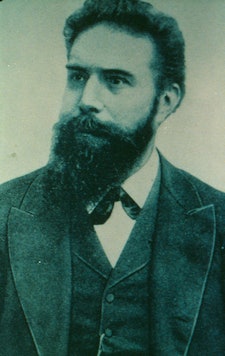 Wilhelm Conrad Roentgen. All images courtesy of Otha Linton.
Wilhelm Conrad Roentgen. All images courtesy of Otha Linton.
In 1895, another German physicist, Wilhelm Conrad Roentgen, the herr professor of physics at Würzburg University, decided to repeat some experiments about cathode rays that he had seen with his friend Philipp Lenard. Previously, Lenard had given Roentgen a vacuum tube with a segment of aluminum in the opposite end from the electric connection.
In April of that year, he experimented with a Hittorf tube to study the fluorescence of the tube when charged with an electric current. Below his glowing tube was a photographic glass plate; on top of the plate was a book with a flat metal key used as a mark.
Photography was part of Roentgen's hobby, but he had no knowledge of electric current exposing anything except the glow of cathode rays. However, when he developed the electric plate, he saw the shadow of the metal key, not visible inside of the book. The professor mentioned the event to some of his students, but no one had any idea of what had happened to produce the image.
On the afternoon of Friday, November 8 -- that dramatic day -- Roentgen was in his laboratory studying cathode rays, using a Hittorf-Crookes tube. To test the penetration of a cathode ray, he wrapped the tube in cardboard. He then darkened the laboratory and turned on the electric current, and the cathode ray appeared.
Across the laboratory, he saw a flicker on a sheet of cardboard that was coated with barium platinocyanide and intended for other experiments. He turned the electric tube off and on. Each time, with some kind of invisible rays, the glow appeared on the chemically coated cardboard sheet. Cathode rays were known not to move away from a vacuum tube.
For several days, Roentgen experimented with the projection of an invisible ray across the laboratory to the barium platinocyanide-coated sheet. When he held objects between the tube and the sheet, the rays penetrated some of them. He could see shadows of metal and other solid objects.
When he held some of the test objects in his hand, he noticed that he could see the bones but not the flesh. He moved the cardboard sheet to further distances, and the invisible beam, which he termed "x-ray," made visible impacts. He found that he could expose photographic glass plates, as had happened in April.
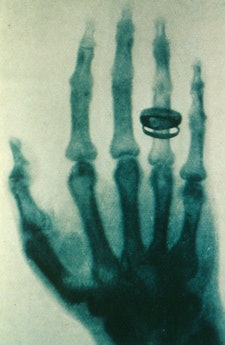 One of Roentgen's early images.
One of Roentgen's early images.
One night, to explain his experiment to his wife, he made an x-ray image of her hand. The bones and the ring appeared, but the flesh was not seen. His wife was frightened, but Roentgen was convinced that he understood the presence of the invisible x-rays and their ability to make images of dense objects and living human bones.
Rather than telling his Würzburg colleagues, his students, or his physics contemporaries about the x-rays, he wrote a scientific paper and attached a few images. On December 28, he submitted the paper to the Würzburg academic publication. Four days later, he received proofs of the article and mailed them to several dozen of his acquainted physicists in Germany, Austria, and other European countries.
One copy went to a friend in Vienna, who passed the article along to his father, the editor of the Vienna Press newspaper. A brief article was published on January 5, 1896. The next day, the story was copied by Vienna correspondents and sent for printing in newspapers around Europe and North America.
Physicists, including Arthur Goodspeed in Philadelphia, read the article, stretched to understanding, and went into their own laboratories to make their own x-ray images. In the same countries, some doctors read the article, noticed the mention of human bones, and concluded that the newly discovered x-rays could make an amazing contribution to advancements of medicine.
Otha W. Linton, MSJ, retired in 1997 as the associate executive director of the American College of Radiology (ACR) after 35 years. He also served as executive director of Radiology Centennial in 1995. Mr. Linton holds a bachelor's degree in journalism from the University of Missouri and a Master of Science in journalism from the University of Wisconsin. His work has been published widely in the U.S. and abroad, and he is a regular contributor to several journals including Academic Radiology, the American Journal of Roentgenology, Radiology, and the Journal of the American College of Radiology. He joined the ACR staff in 1961 and had a key role in its growth. Over the years, his responsibilities with the ACR included government affairs, public relations, marketing, publishing, industrial liaison, and international relations. Just before his ACR retirement, he became the executive director of the International Society of Radiology and continues in that role. Also, since his retirement, he has written and published 14 histories of radiology societies and academic centers.
Sources
Gagliardi RA, McClennan BL. A History of the Radiological Sciences: Diagnosis. Reston, VA: Radiology Centennial Inc; 1996.
Glasser O. Wilhelm Conrad Roentgen and the Early History of the Roentgen Rays. Springfield, IL: Charles C. Thomas; 1934.




